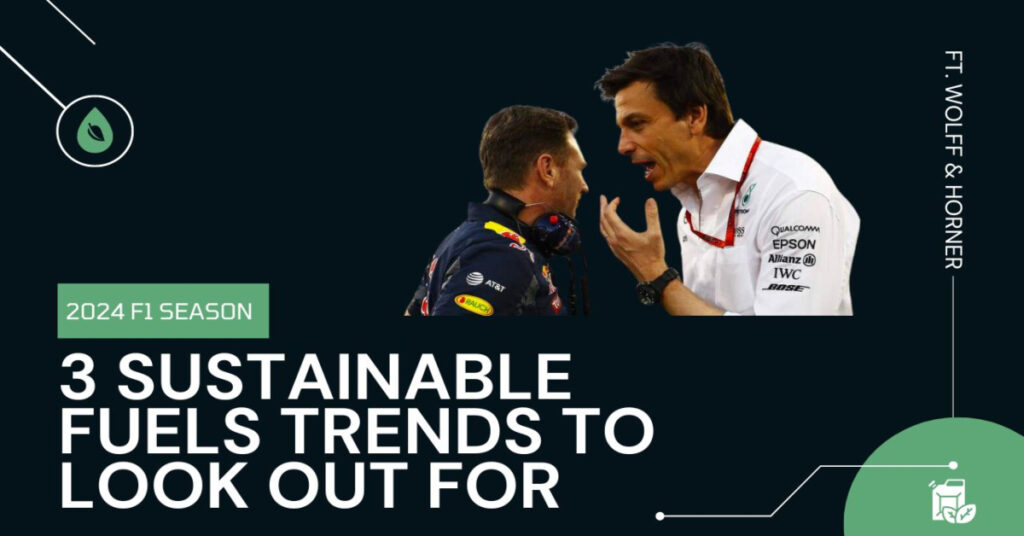2024 Formula 1 season is going to mark exactly two years before sustainable fuels start powering F1 machinery. As we are about to kick off a new campaign in Bahrain, it’s time to reveal 3 sustainable fuels trends to look out for in 2024. Spoiler alert – one of the F1 leading teams may want to spice the things up.
More Formula 1 cars will run on sustainable fuels
Throughout 2023 Sebastian Vettel, unsurprisingly, led the charge advocating for use of sustainable fuels in motorsport. When you hear Sebastian Vettel, you think sustainable fuels. That speaks volumes.
Naturally, it wouldn’t have happened without him taking action. In 2023 Vettel took a wheel of 3 legendary F1 cars from his collection, all of which were powered by sustainable fuels. To find out which vehicles got fuelled by fuel of the future, watch this reel from my Instagram.
Vettel makes it clear. Sustainable fuels have an important role to play. By offering an alternative to fossil fuels, they can save historic racing and keep the internal combustion engine (ICE) alive. And Seb wants more and more people, headed by motorsport enthusiasts, to embrace this perspective.
Prediction: Because of that, I suspect in 2024 we will see even more Formula 1 outings on sustainable fuels. Even though we are talking about firing up old engines in a carbon-neutral manner and only in festival conditions, the prospect of Vettel taking for a spin another F1 classics is exciting. Perhaps we will finally get to see some Ferrari red?
Red Bull vs Mercedes – another battle
In case you forgot, sustainable fuels are only one component of regulations that are set to debut in Formula 1 in 2026. Apart from introducing a brand new environmental-friendly propellant, F1 plan is to increase electric power by three times. Effectively, it will result in 50:50 power ratio.
I am well aware many of you are not particularly happy about that. If you indeed consider yourself in opposition to tripling electric output, you are on the same page with F1’s powerhouse and current world champions – Red Bull Racing. How is that possible?
Well, in 2023 both Christian Horner and Max Verstappen were very vocal about their critique view on 2026 regulations, calling them “terrible”. Red Bull leaders supported their view by the data obtained in the simulator, according to which a 50:50 ratio would force drivers to downshift on the straights to regenerate “colossal” batteries that themselves would compromise weight and cooling.
Read also: 3 milestones that made F1 switch to sustainable fuels in 2026 a reality
Prediction: I sincerely doubt we have seen the end of this saga. Rather the opposite. Horner has been lobbying for reduction in electrical power, and I wouldn’t be surprised if he goes one step further by suggesting giving it up completely. That would force Red Bull to start advocating for a revival of F1 with ICE-powered cars only with one small tweak – 100% sustainable fuels.
If that comes to fruition, Formula 1 is very likely to get another episode of its favourite rivalry. Already in 2023 Red Bull’s and Horner’s actions – you might be shocked – were met with a torrent of criticism from Mercedes and Toto Wolff. That leaves a door open for more fights between the archrivals in 2024 – if not on the track, surely they can create a few sparks off it.
Formula 1 will use more sustainable fuels, but not on track
By this point, even if this article is your first encounter with sustainable fuels in the context of motorsport, you will know that F1 drivers are yet to use them in racing conditions. It doesn’t mean, however, that Formula 1 is not taking advantage of fuel technology of the future.
In 2023 Formula 1 representatives were very proud of the fact that for the European part of the season, they achieved over 80% carbon emissions’ reduction in logistics-related activities. But what exactly made it possible?
Traditional diesel trucks had been replaced by the ones that use HVO (Hydrotreated Vegetable Oil). This type of diesel i.e. produced from waste, residue oil and fats is also fit for generators. As they are often a must-have during a race weekend, HVO plays an important role in lessening the environmental burden of the event.
Prediction: Formula 1 went from testing HVO trucks for just 3 races in 2022 to making the use of them during the entire European leg of the 2023 season. Therefore, I see no reason why F1 can’t extend its off track portfolio of sustainable fuels in the next months. Besides, ambition to become net-zero by 2030 leaves the sport no other choice. Use of sustainable marine fuels (SMF) or sustainable aviation fuels (SAF) either is just around the corner.
